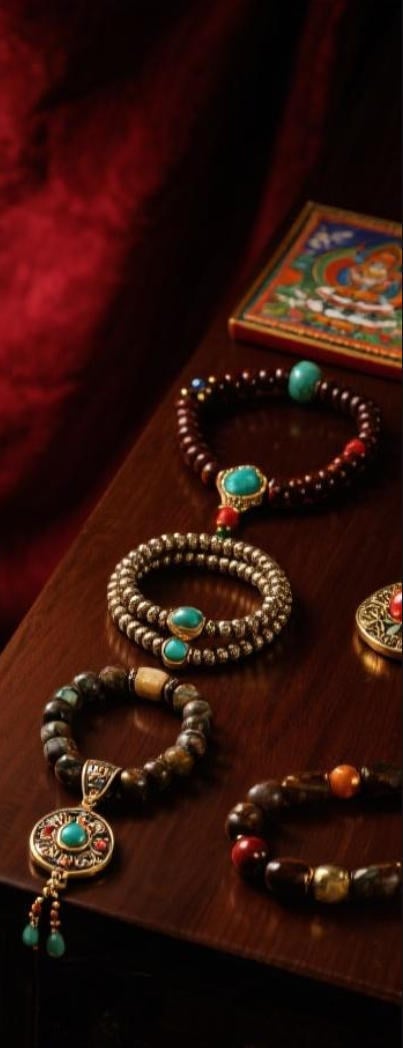
Within the meticulous design within Himalayan spiritualism exist a pair of significant objects: the vivid thangka and holy bodhi talisman. Individually, in particular fashion, offer access to elevated consciousness. The thangka, a decorative panel, renders enlightened figures, ritualistic patterns, or sacred legends, acting as a focus for contemplative thought.
By comparison, the bodhi bead, often crafted from noble stones, wooden material, berries, or osseous matter, is a tangible reminder of Buddha's liberation under the bodhi tree. Clutching the beads in contemplation anchors consciousness.
- Collectively, the thangka and the bodhi bead illustrate the connection of beauty and piety. They offer a tangible link to the ancient wisdom of Tibetan Buddhism.
Tales Whispered by Camel Bone
Spanning bygone centuries, ages-old treasures whisper tales concerning a world long departed. These are not luxurious objects originating in bygone empires, but simple camel bones etched with figures that hold the arcana of a bygone time. Single shards carry the echo emanating from a life lived, a journey experienced, and a connection to the old wisdom which encompasses us all.
- Those
- Elements
- Act as
Decoding the Spirituality of Thangka Artworks
Tangkas are eye-catching paintings on canvas, meticulously crafted by Tibetan artists to depict holy figures and scenes from Buddhist writings. Each detail within a thangka is laden with interpretation, forming a complex tapestry of visual narratives that guide the viewer on a meditative journey. The chromatics used in thangkas are not merely aesthetic choices but carry fundamental connotations, representing different aspects of the Buddhist practice. From the serene figures to the intricate textures, thangkas offer a window into the rich world of Tibetan Buddhism, inviting us to consider upon its understanding.
- Ancient thangka art often depicts key Buddhist figures such as Buddha Shakyamuni, Bodhisattvas like Avalokiteshvara and Manjushri, and enlightened beings from various branches of Tibetan Buddhism.
- Throughout these representations lies a wealth of understanding that can be revealed by those who delve into the symbolic language of thangkas.
Path to the Buddha's Path to Enlightenment: Embodied in Beads and Bone
Upon the winding course to awakening, the Buddha utilized representations imbued with profound influence. Separate bead and bone held within them the quintessence of his wisdom, revealing glimpses into the fabric of reality. Via their figure, the Buddha communicated profound truths that elude the realm of commonplace perception.
From such reflective beads, crafted from special materials, spread vibrations that resonated with the vibrant waves within. The substance of a creature, meticulously transformed into amulets, served as tangible guides of the impermanence fundamental to all manifestations.
Thangkas: Windows into Himalayan Spirituality
Thangkas radiant paintings on cloth serve as effective representations of Himalayan spirituality. These intricate works of art, meticulously created with exquisite brushstrokes, depict a vast array upon Buddhist deities, mandalas, and scenes from holy scriptures. Each thangka is a profound portal for meditation and contemplation, offering wisdom into the complex teachings of Buddhism.
- They are often used in ritual ceremonies as part of
- manifesting states of spiritual awakening.
- Thangkas appear as not merely decorative elements but rather pathways into the rich and fascinating world of Himalayan spiritual traditions.
Bodhi Beads: A Journey Through Mindfulness and Compassion
Each item on a bodhi bead mala whispers tales of ancient wisdom, guiding us on a passage through the tranquil waters of mindfulness. As we grip these intricately made beads, our fingers trace the contours of singular one, anchoring our focus in the present moment. The gentle burden of the beads against our palms serves as a tangible reminder to inhale, fostering a sense of stillness.
- With every bead that passes between our fingers, we foster compassion, extending it first to ourselves and then outward to the world.
- Buddhism teaches us that mindfulness is a craft that requires patience and commitment.
Utilizing the rhythmic repetition of mantra or simply the mindful observation of the beads, we liberate from the relentless chatter of the mind.
The practice employing bodhi beads is a elegant invitation to reawaken our connection with ourselves and the world around us.
Manifesting Intent: Building Camel Bone Bracelets for Sacred Development
Focus represents a compelling drive in our lives, shaping our experiences and guiding us towards our destined path. When we combine this intention with the traditional practices of crafting a camel bone bracelet, we create a potent synergy that can accelerate our spiritual growth.Camel bone remains deeply resonant, representing resilience. Its natural beauty and timeless allure serve as a constant reminder of the elemental strength within each of us.By deliberately picking each shard, channel our desires into the bracelet. With every knot or interlock, we incorporate our hopes, dreams, and aspirations for spiritual evolution. This act of creation becomes a mindful activity, connecting us with our inner wisdom and guiding us on a journey of self-discovery.- Observe how the shade and grain complement your purpose.
- Project your aims as you bind each component.
Camel Bone's Role in Buddhist Iconography
In the rich tapestry encircling Buddhist tradition, artifacts often hold profound symbolic meaning. Among these varied objects, camel bone stands out as a distinct and absorbing element. Across history, this material has been incorporated in the crafting of various Buddhist artifacts, each imbued with specific significances.
- Seen as a symbol of resilience and strength due to the camel's ability to withstand in harsh environments, camel bone often signifies spiritual fortitude.
- Complementarily, the color and texture relative to camel bone are believed on some to hold auspicious connotations, manifesting purity and serenity.
Wherefore, camel bone has become a meaningful part of Buddhist folklore, serving as a tangible nexus to the profound teachings transmitted through this ancient faith.
Thangka Masterpieces: Narratives in Color
Within the ethereal realm of Tibetan Buddhism, Thangka paintings emerge as sacred portals to enlightenment. These exquisite works, meticulously crafted by skilled artists known as thangkapa, depict a myriad with a spectrum of vibrant deities, celestial beings, and mythical creatures. Each brushstroke imbues profound spiritual significance, narrating ancient tales and philosophical theories.
- Offering a vast anthology of Buddhist iconography, Thangkas serve as both devotional objects and instructional tools. Faithful practitioners gaze upon these paintings during rituals and meditations, seeking to cultivate spiritual wisdom.
- Beautifully adorned with intricate details embellished by diverse vibrant hues, Thangkas are considered windows into the divine. Any painting acts as a symbolic representation of the Bodhisattva's teachings and the path to liberation.
With the aid of their intense imagery and symbolism, Thangka paintings offer a glimpse into the rich religious traditions of Tibet. They are a testament to the enduring artistry of Tibetan art and its profound ability to enlighten.
Embracing the Duality: Thangkas and the Cycle of Life and Death
Thangkas, the richly painted Tibetan scrolls, present a deep contemplation on the ephemeral character of existence. Each intricate image depicts deities and beings engaged in the ongoing cycle of life and death, a assemblage of birth, growth, impermanence, and Buddhist prayer beads renewal. The artists skillfully integrate these concepts within the thangka's environment, highlighting the interconnectedness of all things. Through vivid icons, they invite us to deliberate on our own existence. The cycle revolves, a motion of coming and going, pointing out the preciousness of each moment. By embracing this duality, thangkas teach us to respect the beauty in both life's joys and sorrows.Bonds of Serenity: The Significance of Bracelets in Buddhist Practice
In the intricate tapestry of Buddhist practice, seemingly plain objects often hold profound meaning. Among these are bracelets, which serve as tangible badges of devotion and commitment to the practice of Buddha. Worn on the wrist, a bracelet exists as a constant reminder of one's aspirations and goals. It can represent the impermanence of life, prompting practitioners to remain aware in the present moment. Some bracelets may contain sacred marks, such as mantras or the names of Buddhas, which are regarded to draw in positive energy and security. Others tend to be made from elements with spiritual significance, like sandalwood or lotus seeds, increasing the bracelet's meaning. Ultimately, the significance of a Buddhist bracelet resides far beyond its physical form. It becomes a powerful tool for contemplation, a reminder to live in harmony with the teachings of Buddha, and a embodiment of one's unwavering allegiance.